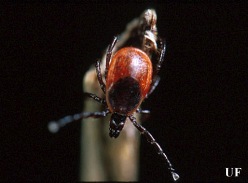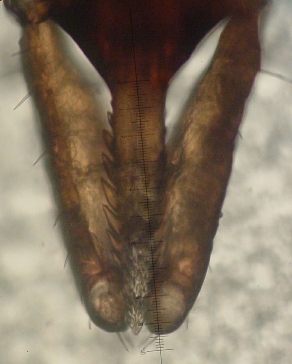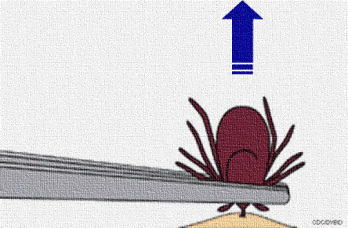
Hide and Seek? Or Hide and
Quest?
Like stated earlier, deer ticks are blood feeding parasites of mammals, birds, and reptiles. In order for the ticks to feed they must come in contact with their host. Ticks seek host in many different ways, but deer ticks do so in an interesting behavior called questing.


Additionally, there are two basic strategies used by arthropod
vectors for finding hosts, passive and active. Species that
engage in passive, such as the deer tick, remain in their habitat
and wait for their host to come to them. Active species leave their
habitat in search for their host. The deer tick waits in the
environment hoping for direct contact with their species walking by,
ambush strategy. Ticks, living in grass, herb, or brush
covered habitats climb the vegetation and wait for a host to brush
against them allowing them to grab on. Vibrations, odors, body
heat, shadows and CO2 given off by animals/host initiate ticks
question pose. Once a host is detected the tick extends and
waves its forelegs rapidly waiting for contact. If contact is made
the tick clings to the host’s body.
The height at which ticks quest is influenced by the host size
they are seeking. This is usually strongly correlated with the
life cycle stage they are occupying. Nymphs usually quest on lower
vegetation such as brush nearer to
 the ground because their targeted
host is usually smaller animals such as
mice,
squirrels and birds.
Likewise, adult ticks are normally found in higher vegetation about
a meter off the ground because they target larger animals as hosts
such as deer. Some ticks can be found near brush and larger
trees such as
maple or
pines trees. Questing height is by no means the sole
determinant of host specificity. The availability and
abundance of hosts also play a role on the host chosen. White-footed
mice and
white-tailed deer are very available and therefore, is the
reason that they are two of the more common hosts found to have
aggregated ticks on them. Another factor that influences host
selection is surface area. The animals with the greatest
surface area are also found to have large amounts of tick invasion.
the ground because their targeted
host is usually smaller animals such as
mice,
squirrels and birds.
Likewise, adult ticks are normally found in higher vegetation about
a meter off the ground because they target larger animals as hosts
such as deer. Some ticks can be found near brush and larger
trees such as
maple or
pines trees. Questing height is by no means the sole
determinant of host specificity. The availability and
abundance of hosts also play a role on the host chosen. White-footed
mice and
white-tailed deer are very available and therefore, is the
reason that they are two of the more common hosts found to have
aggregated ticks on them. Another factor that influences host
selection is surface area. The animals with the greatest
surface area are also found to have large amounts of tick invasion.
Deer ticks are characterized as generalists who are found under
the opportunist category meaning that they are not host-specific and
will feed on a wide range of vertebrates within their questing
height. However, even generalists are known to reject some animals
as hosts. More specifically, deer ticks have evolved a highly
 effected range of pharmacologically active agents in their saliva
which are used to suppress the defense mechanisms in their host.
This behavior decreases the chance for host rejection, however the
saliva of deer ticks does not have the capability to suppress all
animals defense mechanisms and therefore is considered somewhat
host-specific. For example, the deer tick’s saliva, that is ejected
while feeding, has active agents to prevent edema, inflammation and
vasoconstrictions of its host. With this, it is able to suppress the
immune response of the white-footed mouse. However, their saliva
does not contain agents to avoid histamine-induced edema, a
mechanism present in the guinea-pig and therefore cannot use the
guinea-pig as a host because the
guinea-pig will be able to detect
the tick and reject it.
Lastly, macro and microhabitat distribution also influences host
selection. Ticks adapted to a specific habitat will feed on animals
that are also adapted and found in the same habitat. This again, is
one of the reasons deer and mice are the most common hosts found in
the tick’s lifecycle.
effected range of pharmacologically active agents in their saliva
which are used to suppress the defense mechanisms in their host.
This behavior decreases the chance for host rejection, however the
saliva of deer ticks does not have the capability to suppress all
animals defense mechanisms and therefore is considered somewhat
host-specific. For example, the deer tick’s saliva, that is ejected
while feeding, has active agents to prevent edema, inflammation and
vasoconstrictions of its host. With this, it is able to suppress the
immune response of the white-footed mouse. However, their saliva
does not contain agents to avoid histamine-induced edema, a
mechanism present in the guinea-pig and therefore cannot use the
guinea-pig as a host because the
guinea-pig will be able to detect
the tick and reject it.
Lastly, macro and microhabitat distribution also influences host
selection. Ticks adapted to a specific habitat will feed on animals
that are also adapted and found in the same habitat. This again, is
one of the reasons deer and mice are the most common hosts found in
the tick’s lifecycle.
Once the tick has come in contact with a passing host it grabs on
and then begins its feeding process first by securing its
attachment. To begin, the tick pierces the skin, with the aid of the
cheliceral digits. The cheliceral digits do not have the ability to
rotate or pronate and therefore only use horizontal cutting actions
to tear the epidermis. Then it inserts its hypostome, which is the
first mood of attachment, into the host’s skin. (The structures of
these mouthparts are described in more depth in the
adaptations
section.) Then it proceeds to cut the capillaries and other small
blood vessels generating blood flow to the wound site. Again, like
stated above the tick has to suppress the host’s homeostatic
response by pharmacodynamic mechanisms in their saliva.
Like stated earlier, humans can also be a host for the deer tick.
Just like the other animals if a human walks by and is detected by a
questing tick the host can and will grab onto the skin of a human.
It can then crawl on the human to a more secluded area on the humans
body. The same attachment and feeding mechanisms are seen on
humans. If a human spots the tick there are a few ways to get the
tick to detach.
 There are many “folk” methods of getting the tick to
“back out” from the skin, however it is very important you do this
in the proper way to make sure you get all of the mouthparts out of
your skin. If you remove the tick improperly, there is a good
chance the hypostome is still under your skin and cause further
irritation and infection. The other reason it is important to
properly remove the tick is because you do not want to crush the
tick while inside your skin, if the tick is infected with
Lyme
Disease it can be transmitted to the human if crushed. The
“myth” stating to cover the butt of the tick with nail polish or
rubbing alcohol is shown to be ineffective. As well as the “myth” to
light a match stick, blow it out and touch the butt of the tick. The
most effective way to remove a tick it to use a forceps or household
tweezers to physically pull the tick out. It is very important to
place the tweezers as close to the skin and mouthparts as possible.
Then with a steady tugging motion the tick and its mouthparts should
detach from the skin, do not twist or jerk the tick. If located in
an area with
Lyme Disease, it is encouraged to take the tick to a
physician.
There are many “folk” methods of getting the tick to
“back out” from the skin, however it is very important you do this
in the proper way to make sure you get all of the mouthparts out of
your skin. If you remove the tick improperly, there is a good
chance the hypostome is still under your skin and cause further
irritation and infection. The other reason it is important to
properly remove the tick is because you do not want to crush the
tick while inside your skin, if the tick is infected with
Lyme
Disease it can be transmitted to the human if crushed. The
“myth” stating to cover the butt of the tick with nail polish or
rubbing alcohol is shown to be ineffective. As well as the “myth” to
light a match stick, blow it out and touch the butt of the tick. The
most effective way to remove a tick it to use a forceps or household
tweezers to physically pull the tick out. It is very important to
place the tweezers as close to the skin and mouthparts as possible.
Then with a steady tugging motion the tick and its mouthparts should
detach from the skin, do not twist or jerk the tick. If located in
an area with
Lyme Disease, it is encouraged to take the tick to a
physician.
To learn more about how I transmit Lyme Disease Click here
To Main Page